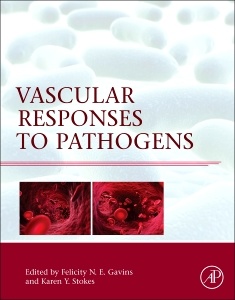Description
Vascular Responses to Pathogens
Coordinators: Gavins Felicity N.E., Stokes Karen Y.
Language: English
Subjects for Vascular Responses to Pathogens:
Keywords
adhesion molecules; antibiotics; antimicrobials; antiretroviral; atherosclerosis; autoimmune; bacteremia; bacteria; Bartonella; Brugia malayi; CagA; cardiovascular disease; Chagas disease; Chlamydia pneumoniae; coxsackievirus; cytokines; cytomegalovirus; dengue hemorrhagic fever; diagnosis; dilated cardiomyopathy; disease; dyslipidemia; endocarditis; endothelial activation; endothelial cell; endothelial dysfunction; endothelial mesenchymal transition; endothelin; endothelium; Env; fibrosis; fluid resuscitation; gp120; Group B Streptococcus (GBS); Helicobacter pylori; hemostasis; herpes simplex; herpesviruses; histone; HIV-1; host defense; host response; Hp-NAP; hydrocele; immunity; immunopathology; infection; inflammation; leukocyte recruitment; lipid metabolism; lymphangiogenesis; lymphatic filariasis; lymphedema; macrophages; microcirculation; mitochondrial toxicity; monocytes; myocarditis; Nef; Neisseria meningitidis; NETosis; NETs; neutrophils; nitric oxide; NNRTI; NOD2; NRTI; One Health; oxidative stress; pathogenesis; pathology; periodontitis; persistence; platelets; Porphyromonas gingivalis; protease inhibitor; randomized controlled trials; reactive oxygen species; Rickettsia; risk factors; senescence; sepsis; signal-transduction mechanisms; smooth muscle; smooth muscle cell proliferation; source control; surface adhesins and invasins; Surviving Sepsis Campaign Guidelines; Tat; Th1; the blood-brain/cerebrospinal fluid barrier; thromboxane A2; tissue oxygenation; TLR2; toll-like receptors; Trypanosoma cruzi; VacA; vascular; vascular disease; vascular dysfunction
252 p. · 21.4x27.6 cm · Hardback
Description
/li>Contents
/li>Readership
/li>Biography
/li>Comment
/li>
Vascular Responses to Pathogens focuses on the growing research from leaders in the field for both the short and long-term impact of pathogens on the vasculature. It discusses various organisms, including bacteria, parasites, and viruses, and their role in key events leading to vascular disease.
Formatted to discuss the topic of the interaction of pathogens with the vascular rather than individual diseases described separately, this reference demonstrates that common mechanisms are at play in many different diseases because they have a similar context, their vasculature.
This all-inclusive reference book is a must-have tool for researchers and practicing clinicians in the areas of vascular biology, microvasculature, cardiology, and infectious disease.
Chapter 2: Sepsis
Chapter 3: Neutrophil Mediated Vascular Host Defense
Chapter 4: Platelet-Bacteria Crosstalk
Chapter 5: Mechanisms of bacterial interaction with cells of the blood-cerebrospinal fluid barrier
Chapter 6: Vascular Responses to Chlamydia Pneumoniae Infection
Chapter 7: Bartonella Species and Vascular Pathology
Chapter 8: Periodontal Innate Immune Mechanisms Relevant to Atherosclerosis
Chapter 9: H. Pylori
Chapter 10: Vascular Responses to Pathogens: Rickettsia
Chapter 11: Herpes Viruses
Chapter 12: HIV/Antiretrovirals
Chapter 13: Viral Myocarditis and Dilated Cardiomyopathy: Mechanisms of Cardiac Injury, Inflammation and Fibrosis
Chapter 14: Viruses responsible for Hemorrhagic fevers
Chapter 15: Trypanosoma cruzi and Chagas disease: Innate immunity, ROS, and Cardiovascular System
Chapter 16: Endothelial cells as Targets of the intravascular parasitic disease Schistosomiasis
Chapter 17: Vascular responses in Human Lymphatic Filariasis
Chapter 18: The Treatment of Sepsis: From Failed Therapies to New Possibilities
Cardiovascular researchers, cardiologists, and infectologists in particular in the areas of vascular biology, cardiology, and infectious disease
Dr. Stokes major area of research is the inflammatory impact of cytomegalovirus on the microvasculature. Her diverse research team is comprised of post-doctoral scientists and students, with an international reputation. Their research crosses the boundaries between Integrative Physiology and Pharmacology and uses multidisciplinary approaches to advance understanding of the vascular physiology and pathophysiology of inflammatory and related disorders, at the molecular, cellular, tissue and whole organism levels. In particular she and her team focus on the microcirculation, studying leukocyte trafficking and endothelial dysfunction in both the brain and the periphery.
- Covers a wide spectrum of organisms and provides analysis of pathogens and current therapeutic strategies in the context of their vasculature
- Provides detailed perspectives on key components contributing to vascular pathogens from leaders in the field
- Interfaces between both vascular biology and microbiology by encompassing information on how pathogens affect both macro and microvasculature
- Includes coverage of the clinical aspects of sepsis and current therapeutic strategies and anti-sepsis drugs
These books may interest you

Textbook of Vascular Medicine 84.39 €

Textbook of Vascular Medicine 116.04 €


